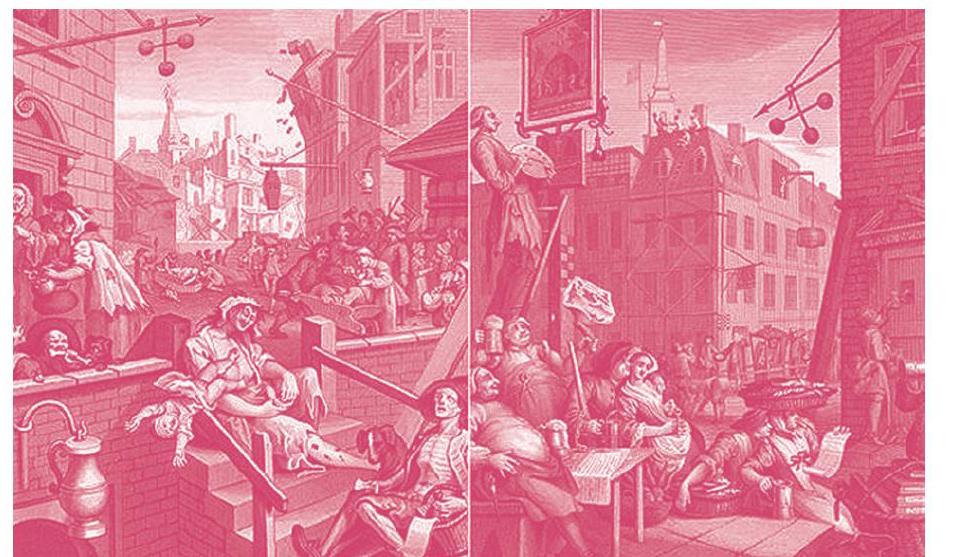The Great British Pub美妙的英国酒吧
本·约翰逊

Renowned the world over, the great British pub is not just a place to drink beer, wine, cider or even something a little bit stronger. It is also a unique social centre, very often the focus of community life in villages, towns and cities throughout the length and breadth of1 the country.
Yet it appears that the great British pub actually started life as a great Italian wine bar, and dates back almost 2,000 years.
It was an invading Roman army2 that first brought Roman roads, Roman towns and Roman pubs known as tabernae3 to these shores4 in 43 AD. Such tabernae, or shops that sold wine, were quickly built alongside Roman roads and in towns to help quench the thirst of the legionary troops.
It was ale, however, that was the native British brew, and it appears that these tabernae quickly adapted to provide the locals with their favourite tipple5, with the word eventually being corrupted6 to tavern.
These taverns or alehouses not only survived but continued to adapt to an ever changing clientele7, through invading Angles, Saxons, Jutes, and not forgetting those fearsome Scandinavian Vikings8. In around 970 AD, one Anglo-Saxon king, Edgar, even attempted to limit the number of alehouses in any one village. He is also said to have been responsible for introducing a drinking measure9 known as ‘the peg10 as a means of controlling the amount of alcohol an individual could consume, hence the expression “to take (someone) down a peg”.
Taverns and alehouses provided food and drink to their guests, whilst inns offered accommodation for weary travellers. These could include merchants, court officials or pilgrims travelling to and from religious shrines, as immortalised11 by Geoffrey Chaucer12 in his Canterbury Tales13.
Inns also served military purposes; one of the oldest dating from 1189 AD is Ye Olde Trip to Jerusalem in Nottingham, and is said to have acted as a recruitment centre for volunteers to accompany King Richard I (The Lionheart)14 on his crusade to the Holy Lands.
Alehouses, inns and taverns collectively became known as public houses and then simply as pubs around the reign of King Henry VII. A little later, in 1552, an Act was passed that required innkeepers to have a licence in order to run a pub.
By 1577 it is estimated that there were some 17,000 alehouses, 2,000 inns and 400 taverns throughout England and Wales. Taking into account the population of the period, that would equate to around one pub for every 200 persons. To put that into context, that same ratio today would be approximately one pub for every 1,000 persons... Happy Daze!
Throughout history, ale and beer have always formed a part of the staple British diet, the brewing process itself making it a much safer option than drinking the water of the times.
Although both coffee and tea were introduced into Britain around the mid-1600s, their prohibitive15 prices ensured that they remained the preserve16 of the rich and famous. Just a few decades later however, things changed dramatically when cheap spirits, such as brandy from France and gin from Holland hit the shelves of the pubs. The social problems caused by the ‘Gin Era of 1720–1750 are recorded in Hogarth17s Gin Lane18.
The Gin Acts of 1736 and 1751 reduced gin consumption to a quarter of its previous level and returned some semblance19 of order back to the pubs.
The age of the stagecoach heralded yet another new era for the pubs of the time, as coaching inns were established on strategic20 routes up and down and across the country. Such inns provided food, drink and accommodation for passengers and crew alike, as well as changes of fresh horses for their continued journey. The passengers themselves generally consisted of two distinct groups, the more affluent who could afford the relative luxury of travelling inside the coach, and the others who would be left clinging on to the outside for dear life. The ‘insiders would of course receive the warmest greetings and be welcomed into the innkeepers private parlour or salon (saloon), the outsiders meanwhile would get no further than the inns bar room.
The age of the stagecoach, although relatively short-lived, did establish the precedence for the class distinctions that was continued in rail travel from the 1840s onward. Like the railways that operated a First, Second and even Third Class service, so the pubs evolved in a similar manner. Pubs of that time, even relatively small ones, would typically be split into several rooms and bars in order to cater for differing types and classes of customer.
In todays ‘open-plan society such walls have been removed, and now anyone and everyone is welcome in the great British pub. So welcome, in fact, that almost one in four Britons will now meet their future wife or husband in a pub!
Historical Note: The native British brew of ‘ale was originally made without hops. Ale brewed with hops was gradually introduced in the 14th and 15th centuries, this was known as beer. By 1550 most brewing included hops and the expression alehouse and beerhouse became synonymous. Today beer is the general term with bitter, mild, ales, stouts and lagers simply denoting different types of beer. ■
英国的酒吧闻名于世,不可小觑。这里不仅是人们喝啤酒、葡萄酒、苹果酒甚或更烈一些的酒品的场所,而且还是别具一格的社交中心,全国各地乡村、镇落、城市的社区生活往往汇集于此。
然而,美妙的英国酒吧其实发端于同样美妙的意大利葡萄酒酒吧,其历史可追溯至近2000年前。
公元43年,罗马侵略军首次将罗马式道路、罗马式城镇和被称为tabernae的罗马式酒吧带入英国。为了让军团士兵一解近渴,这种销售葡萄酒的商铺很快就在罗马式道路旁和城镇中建了起来。
然而,麦芽酒才是英国本土的自酿酒。于是,这些商铺很快便入乡随俗,为当地人提供他们最爱的酒品。tabernae一词最终也讹变为tavern(酒馆)。
这些酒馆或酒屋,不仅得以幸存,而且还一直适应着不断变化的酒客们——陆续侵入的盎格鲁人、撒克逊人以及朱特人,也包括那些骇人的斯堪的纳维亚维京人。公元970年左右,盎格鲁-撒克逊国王埃德加竟试图限制每个村庄的酒屋数量。相传,为了控制人们的酒量,他还推行一种被称作peg(浅酌)的饮酒标准,于是便有了“to take (someone) down a peg[煞煞(某人)的酒威]”这一表达。
酒馆和酒屋为来客提供食物和酒水,酒栈则为劳顿的旅人提供住宿。这些旅人包括往来于宗教圣地的商人、朝臣等朝圣者——杰弗雷·乔叟的《坎特伯雷故事集》让这些朝圣者名垂千古。
此外,酒栈也曾用于军事目的。坐落在诺丁汉的“老耶路撒冷之旅”是最古老的酒栈之一,其历史可追溯至公元1189年。相传,这家酒栈曾用作志愿兵征募中心,征来的士兵要跟随国王理查一世(“狮心王”)率领的十字军一同东征圣地。
当时,酒屋、酒栈、酒馆统称为public houses,后来又在国王亨利七世统治时期简称为pubs,即酒吧。不久后的1552年,议会通过一项法案,要求酒栈老板必须持有执照才能经营酒吧。
据估算,到1577年,英格兰和威尔士境内大约有17,000家酒屋、2000家酒栈和400家酒馆。如果将当时的人口数量考虑在内,这相当于大约每200人一家酒吧。照此计算,这一比例在今天大致相当于每1000人一家酒吧……可真是一种享受啊!
在整个历史中,麦芽酒和啤酒一直是英国主食的一部分,其酿制过程本身决定了在那个时代,饮酒要比饮水安全得多。
尽管17世纪中期前后英国引入了咖啡和茶,但是二者高昂的价格使其成为富人和名流的专享饮品。然而,仅几十年后情况就发生了剧变,源自法国的白兰地酒和荷兰的杜松子酒等廉价烈性酒开始出现在英国酒吧的货架上。1720年至1750年的“杜松子酒时代”引发了一系列社会问题,这在霍加斯的画作《杜松子酒巷》中皆有展现。
1736年和1751年出台的《杜松子酒法案》使杜松子酒的消费量降到了此前水平的四分之一,也使酒吧的秩序在表面上有所恢复。
驿站马车时代的到来预示着酒吧再次步入新的发展时期,因为当时纵横英国的重要线路沿途都建起了马车酒栈。这种酒栈为旅客和车夫提供餐饮和住宿,同时还为他们更换新马匹,以便继续赶路。一般而言,旅客本身可明显划为两类:一类是财力雄厚者,能享受到旅行时坐在车内的较好待遇;另一类则暴露在车外,行路时需要死命地抓牢马车。“车内客”当然会受到最热情的迎候,还能进入酒栈私人会客厅,而“车外客”就只能待在栈内的酒吧间。
驿站马车时代尽管相对短暂,却确立了基于阶层差异的优先规则,这种规则自19世纪40年代起一直在铁路客运中沿用。正如铁路客运有一等座、二等座乃至三等座服务之分,酒吧也以相似的方式演变着。为了迎合不同类型、不同阶层顾客的需求,当时的酒吧通常会分隔为若干个房间和吧间,即便是较小的酒吧也是如此。
今天的社会讲求“开放式布局”,这类隔断墙已不见了踪影。现在,美妙的英国酒吧欢迎每一位酒客的到来。一个人所乐见的事实便是:现在大约每四个英国人中就有一个会在酒吧结识未来的另一半!
史注:起初,英国本土的“麦芽酒”在酿制过程中不使用啤酒花。加入啤酒花酿制的麦芽酒在14至15世纪才逐渐引进英国,这种酒被称作啤酒。到了1550年,大多数酿制酒都加入了啤酒花,alehouse(麦芽酒屋)和beerhouse(啤酒屋)便成了同义词。如今,啤酒只是一个泛称,可指苦啤、淡啤、艾尔啤、烈性黑啤、拉格啤等各类啤酒。 □
(譯者单位:北京外国语大学高级翻译学院)
1 throughout the length and breadth of到处,遍及。 2指罗马帝国侵略军。罗马帝国(公元前27—公元1453)以地中海为中心,跨越欧、亚、非三个大洲。 3 tabernae为拉丁语taberna的复数形式。最早指单间商铺,多建在家庭住宅一层,一侧面朝街道,后随着罗马帝国的经济日渐繁荣,开始建在室内市场中,销售谷物、面包、葡萄酒、珠宝等商品。 4 shores濒海国家,这里指英国。
5 tipple烈酒,常喝的酒。 6 corrupt讹用(语、词等),使(文本等)掺杂讹误。 7 clientele(统称)顾客,客户。 8 Viking意为“来自峡湾的人”。维京人泛指生活于公元800—1066年间所有的斯堪的纳维亚人。他们从事广泛的海外贸易和殖民扩张。 9 measure(酒的)标准量。 10 peg少量烈酒。 11 immortalise使不朽(尤指通过文学艺术作品等)。 12英国小说家、诗人,被公认为中世纪英国最伟大的诗人之一。 13乔叟创作于1386—1400年间的诗体短篇小说集,记录了来自英国社会各阶层的30名朝圣者往返于宗教圣地坎特伯雷途中所讲的故事,故事题材涉及探险传奇、宗教和道德训诫、动物寓言等。
14金雀花王朝的第二位英格兰国王,1189年至1199年在位,因骁勇善战而号称“狮心王”。 15 prohibitive(价格)令人望而却步的。 16 preserve专门领域,这里指专用品。
17英国著名版画家、讽刺画家,其作品多讽刺所处时代的政治和风俗。 18霍加斯创作于1751年的一幅版画,描绘了伦敦街头人们酩酊大醉、放荡淫乱的场景。 19 semblance表象,外观。 20 strategic(战略上)重要的;要害的。

